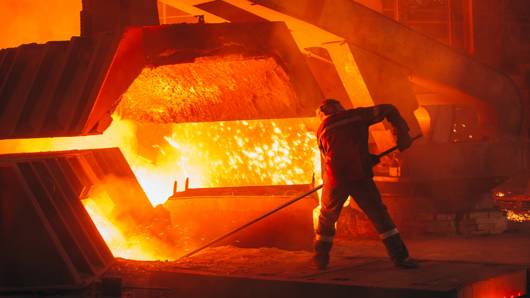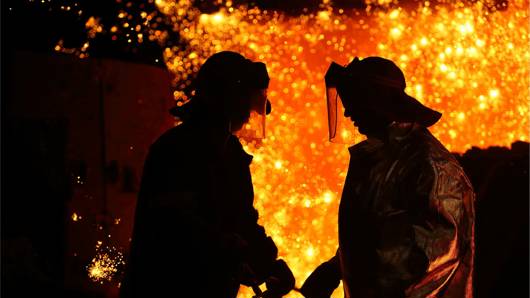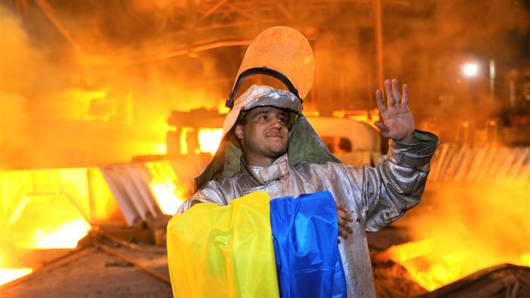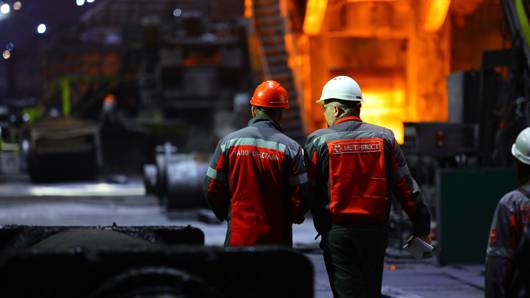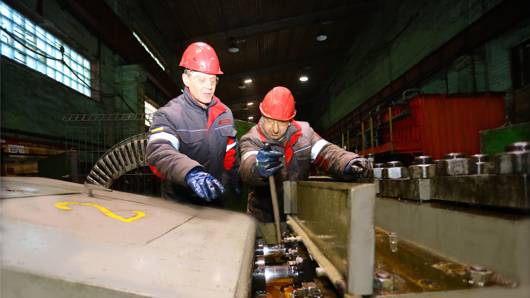In an interview with Forbes Ukraine, CEO of Metinvest Group sums up the results of 2023 for the Group, speaks about green transformation plans, military production, adaptation during the war, and the main security and business factors that shaped the picture of the past year.
About the year’s results
Metinvest earned US$47 million in profit in the first six months of the year. The result for 2022 was a loss of US$2.2 billion. Can we say that the company has fully adapted to the new conditions?
The main thing we have managed to do is build new supply chains and find alternative sources of raw materials we need for production. For example, we previously produced coke at Avdiivka Coke. Now we buy it in Poland. We have also found suppliers in Hungary and Italy. The same goes for the rest of the products. This has allowed us to stabilise the processes at our plants. Steelmakers earn money only when they work steadily and when there are no major fluctuations in production.
So, yes, we can now say that we have finished adapting the Group to the new conditions. I cannot comment on the year’s results until they are published publicly on the stock exchange.
When was the last time the Group paid dividends? Do you plan to pay them according to this year’s results?
The last time dividends were paid based on the results of 2021. It is unlikely that we will pay dividends this year. First, dividend payments are not our main priority now. Second, we need to service our debts. The Group’s total debt as of 30 June 2023 is about US$1.9 billion. The nearest bond maturity is in 2025. So, we are primarily focused on this.
How much has the proportion between imports and exports changed compared with the period before the Russian invasion?
Metinvest used to import a lot. For example, we were the largest importer from the US, where our coal mines are located and where we bought coking coal, to Ukraine. However, we were also the largest exporter from Ukraine to the US, selling pig iron there.
The proportion has not changed much now, as our general import needs have significantly decreased due to the loss of operational control over Azovstal, Ilyich Steel and the suspension of Avdiivka Coke.
What is the condition of Avdiivka Coke?
The plant is under the control of the Ukrainian army. It has been shelled by Russia many times. They fired at it with everything they had. I think it will be impossible to restore the plant.
However, it is unlikely that it will need to be rebuilt in the way it was before the invasion. The major coke consumers from Avdiivka Coke were Azovstal and Ilyich Steel and we are not talking about restoring them in the foreseeable future until we are back in Mariupol. We want to restore Azovstal, but it will be a completely different plant.
How will the role of Mariupol change after the de-occupation, in your opinion?
While metallurgy will remain a part of the city, it will no longer be its backbone. Mariupol can be a resort city. Tourism can be the main sector of the city’s economy. There is also potential in engineering, shipbuilding and science.
However, this will depend on the conditions under which the war ends. This will determine who will be willing to come to live in the city. Mariupol is less than 50 km from the Russian border.
Metinvest Polytechnic was to become one of the magnets of Mariupol. What is the project’s status now?
Indeed, we saw this project not only as an educational one but also as a centre of attraction. The idea for this university was not only to train experienced technical specialists, but secondly, we needed to attract people to Mariupol, so to speak. While it was a frontline city, there was a steel industry there, and we needed people and students to come there.
In 2022, we launched a fully online programme, and in 2023, we switched to a hybrid form. We have both online and offline lectures in Kryvyi Rih and Zaporizhzhia. The most popular specialities are metallurgy and ecology. That is, we are now training specialists who will drive the Group’s green transformation.
Do you plan to return to the idea of building a university and where?
We have not abandoned this idea, but it will have to wait until after the war. It could be one of the cities of our presence: Zaporizhzhia, Kryvyi Rih, Kamianske or Mariupol.
About the modernisation of Ukrainian assets
The EU introduced a new carbon tax in a test mode in 2023, which will be fully operational in 2026. How does this affect your plants?
We do not expect any changes for our EU plants, as they mostly buy slabs within the EU. For our Ukrainian plants, this is a challenge. We will not be able to rebuild our plants by 2026 due to the war. There are two options: Ukraine’s accelerated accession to the EU and joining the European Emissions Trading System (EU ETS); or postponing the requirements of the CBAM [Carbon Border Adjustment Mechanism] for Ukraine.
If there was no war, we would have had time to prepare. We planned to rebuild our plants to produce low-carbon steel. We were considering building electric arc furnaces at Zaporizhstal instead of open-hearth furnaces. We also planned to modernise Kamet Steel and Ilyich Steel.
Therefore, we have an objective reason to ask for a delay given the war in the country. All steelmakers in the EU started their green transformation simultaneously, but we have lost at least two years. We cannot invest in large-scale projects in Ukraine now because investors cannot provide financing at normal interest rates.
What percentage are they willing to lend at?
They are ready to lend at 20% plus, but in this case, such projects will never pay off. Before the full-scale war, we were borrowing at less than 7%.
What is the asking price?
We estimated the modernisation of Zaporizhstal at around US$2 billion. However, green steelmaking requires a substantial amount of scrap metal, or high-quality DR pellets. Ukraine does not have enough scrap metal to meet the demand from modernised Zaporizhstal, Kamet Steel and ArcelorMittal Kryvyi Rih. Therefore, we will need to modernise our GOKs simultaneously to produce high-quality pellets.
If we sum up the investments in the green transformation of our Ukrainian assets – the GOKs, Kamet Steel and Zaporizhstal – the total amount is about US$9 billion. It is feasible and we plan to implement it after the war is over. This is an investment programme for 5-10 years.
What are the practical implications for your company from 2026 if there is no delay?
Due to the additional carbon tax on our products, in a certain period, they may become uncompetitive in the EU market. That is, there may be a situation when our exports to the EU will be blocked.
How do you see a way out of the situation if the war drags on? Are war risk insurance mechanisms realistic?
The only way out is to end the war. The insurance mechanism still looks too complicated to implement.
About the construction and acquisition of plants in the EU and Zaporizhstal’s Russian co-owners
Metinvest announced plans to build a plant in Italy this year. What is the goal and why Italy?
Yes, we are planning to build a new rolling mill in Italy with a capacity of around 3 million tonnes of steel. We are currently negotiating for a land plot where we can build the facility. This plant would help to increase the capacity utilisation of our Ukrainian GOKs and encourage their modernisation to produce high-quality pellets. The EU also has insufficient scrap metal to supply all the steel mills that are currently being modernised.
We chose Italy because it is the largest importer of rolled steel in the EU. It means that we will not compete with local producers, but rather replace imports.
Who are your partners in this project?
Our partner is the Italian company Danieli, a global manufacturer of steelmaking equipment. A crucial aspect for us is that they have announced their withdrawal from the Russian market. We also count on the support of the Italian government. There are institutions in Italy that provide loans and grants for such projects. Therefore, we expect that the majority of funding for the construction of this plant will come from grants and debt.
What are the deadlines and cost of the plant construction?
If all goes according to plan, we can start construction next year and build it in 3-4 years. The cost of the plant is comparable to the reconstruction of Zaporizhstal. These are two very similar projects. We consider it a sort of pilot project for the reconstruction of Zaporizhstal.
Earlier, Metinvest explained the lack of large investments in the modernisation of Zaporizhstal by the fact that it only owns half of the plant. Now the other half of the plant has been arrested. Does this open up investment opportunities?
The war restrains investments now. If there was no war, it would be a different case.
Are you interested in taking this stake under management or purchasing it?
So far, this stake has been arrested but not nationalised. As long as there is a war going on, it is probably inappropriate to say whether we are interested in it. If the government takes this stake and auctions it, we will participate in it. If the government decides that this stake should be kept by the state, we are not against having such a partner. It would be even better, since we would carry out the modernisation together with the state and divide the investment in half.
Do you know who really owns this stake? Supposedly, it belongs to Russia’s Vnesheconombank, and sanctions have also been imposed on Armenian citizens.
I know no more than you do. Indeed, there is a hypothesis that the stake was held by Vnesheconombank and legally owned by Armenian citizens. Now, as I understand, the Security Service of Ukraine is trying to find a connection with the Russian bank and nationalise this stake.
The second arrested asset is Kryvyi Rih Iron Ore Plant. Who manages the plant now?
KZHRK is not part of Metinvest. SCM owns half of the plant, so this question should be addressed to them. We buy ore from KZHRK but do not manage it.
You also planned to buy the Hungarian Dunaferr plant. Why do you think you were not allowed to participate in the tender?
In my opinion, it was a non-transparent tender in which we were excluded for bureaucratic reasons: we failed to provide some paperwork on time.
Did you discuss this situation with the Hungarian government and Liberty Steel? What could have been behind it?
We did not go into the details of this case. It is not our job. In my opinion, there could have been political reasons. It was a political decision not to allow a Ukrainian company to enter Hungary.
However, we should look at the result: the plant does not operate. There is a similar situation in Romania: the Liberty Steel plant in the Romanian city of Galati also does not operate. We were also excluded from that tender.
It was predictable. Analysts had predicted that Liberty Steel had no resources to launch the plant. There was a theory that Liberty could resell it to you. Have you discussed this possibility with them?
There are questions not only for Liberty, but also for the Hungarian government, which has not fulfilled its obligations to launch the plant.
Now the question is whether we are interested in buying it. We were very interested in this plant when the ports were closed to load our GOKs. Now the situation has changed, time has passed. In addition, we must not forget about the path towards green steelmaking. We would need to invest in this plant to launch it and then invest in its modernisation.
If someone offers, we will consider it. But for now, I am not sure we are ready to buy it.
Are you also not interested in other EU plants near the Ukrainian border?
I cannot disclose ongoing negotiations. We have always been interested in plants near the Ukrainian border, which have traditionally focused on Ukrainian ore. If such a plant really allows us to increase the workload of our Ukrainian assets, it would create additional jobs in Ukraine. While this matter remains open, we are adapting our strategy.
Are you still considering modernising your Bulgarian plant, Promet Steel, to load Ukrainian GOKs?
We had two options: modernisation, which would effectively entail the construction of a new plant in Bulgaria, or a new plant in Italy. We chose the second option. Even though there has been a project dating back to the 1980s to build a plant at our site in Bulgaria for raw materials from Kryvyi Rih. Unfortunately, though, there is no market in Bulgaria now. We would still have to transport the products from this plant to Italy. Therefore, it is better to build it in Italy.
About the sea corridor, military orders and Ukrainian Railways tariffs
How do you assess the work of the alternative sea corridor? How does it affect the workload of your plants?
Not much has changed for our steel plants. They have been utilised at 65-75% throughout the year. At the beginning of the war, two blast furnaces were undergoing major repairs – one at Zaporizhstal and one at Kamet Steel – and right now we cannot use them to increase our utilisation.
The impact on our GOKs is more significant. We had two markets for our ore before the sea corridor was opened: intra-group consumption in Ukraine and Eastern Europe. This allowed us to utilise our GOKs at 35-40%. Now we are expanding our geography: Southern Europe, Italy, Turkey and Egypt. But the China is the largest. We are likely to increase the utilisation rate of our GOKs to around 75-80% by the end of the first quarter of next year if the corridor operates steadily.
That will be the highest utilisation level possible until the end of the war. We do not have enough workers. Some people have gone abroad, while 8,000 of our employees serve in the Armed Forces of Ukraine. There is no way to cover this deficit to increase production even further.
What is the share of sea exports?
More than 50% of our exports are now going through the ports of Odesa. We exported almost 100% by rail before the opening of this corridor.
What is the corridor’s potential in terms of tonnes?
We expect that by the end of the first quarter of 2024, seaborne ore exports will reach their maximum of 2-3 million tonnes per month for all Ukrainian producers. Metinvest alone shipped a maximum of 2 million tonnes of ore per month before the war. However, there is still potential to expand to other types of products from Ukrainian exporters: metal, coal and cement.
What will it depend on?
On how quickly ports can tranship products. In turn, this depends on how effectively our air defence system protects port infrastructure from Russian strikes.
Some companies create mobile air defence groups to protect their facilities. Do you plan to do this as well?
We try to do only what we are good at. We are most effective in this way. That is why we do not create such groups and do not plan to. However, we produce a lot of other products for the Armed Forces of Ukraine: mobile dugouts for the Ukrainian Defence Forces, as well as mine trawls and other equipment for our military. But we think it is inappropriate to set up our own air defence system. We have the Armed Forces of Ukraine; we have professionals engaged in this. They have already learned a lot in nearly two years. In terms of defending the sky, they have learned almost everything.
So, you feel that the Ukrainian military-industrial complex is growing? Your plants were an integral part of the Soviet defence industry.
Yes, most of what we supply to the army now is indeed products based on Soviet-era drawings we found at our plants. However, we cannot say that this work is carried out on an industrial scale. We do it in our free time. We have only produced eight mine trawls, and the army needs hundreds of them.
We expect the Ukrainian military-industrial complex to grow faster and involve private companies like ours. If we receive an order from the state, we will open new workshops, hire employees and produce these mine trawls in the volumes the state needs.
I hope that [Ukraine’s Minister of Strategic Industries] Oleksandr Kamyshin and [Minister of Defence] Rustem Umerov will be able to engage private companies in the military-industrial complex. I am not talking about tank production; we are not able to do that. But we are ready to do what we can do in the required volumes.
Ukrainian Railways plans to index freight tariffs next year. What is your position?
As far as I know, the financial plan approved by the government does not include indexation. But Ukrainian Railways does want to raise tariffs. This is a normal want of any monopolist. What is our position? We will keep talking and explaining that now is not the time for this.
Ukrainian Railways is about to receive new volumes of ore transported to ports, which will bring them much more money than raising tariffs. In my opinion, they need to focus on their efficiency and on increasing their turnover, and then they will no longer need to raise tariffs.
They increased tariffs by 70% last year, which affected the industry significantly. Not only steelmakers, but also farmers. We have not seen such inflation since then.
A lot of inefficiencies have been passed on to business. There are military factors and others. But it all has been simply passed on to the business community, which is not in the best position now. Ukrainian Railways needs to look for internal efficiencies, because the increase that took place last year should cover all these additional issues.
Tariff harmonisation is another idea of Ukrainian Railways. Do I understand correctly that tariff harmonisation is beneficial for the metals and mining complex?
I think this is a dangerous thing because there are objective economic reasons why tariffs are different. For example, when you ship ore, you load the whole shipment in Kryvyi Rih. We load it by ourselves. We put it on public railway tracks and then the railway takes it from point A in Kryvyi Rih to point B, the Southern Port. It is straightforward. Then, for example, there is grain. That is a different situation, because you need to collect grain from many points, at various small stations, and process it. This means separate points to which it needs to be transported. It turns out that the cost of transportation is different, so the tariff cannot be the same.
Please do not misunderstand, we support the reform of Ukrainian Railways’ tariff policy. This would be a normal way to go if we redesigned the entire system, balanced it and introduced some incentives. For example, an incentive to ship in batches. That is why tariff reform is needed: it is long overdue. As is as the reform of Ukrainian Railways as a whole: dividing the company into passenger and freight.
But so far, everything has come down to the banal: “We should raise tariffs”. Perhaps they do have the right ideas, but I do not know about them yet.






